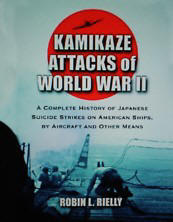![]()
Updated 11/22/2010
|
Kamikaze Attacks of World War II By Robin L. Rielly 376 pp. $55.00
A review, By John Rooney This complete history of the kamikaze phenomenon in World War II documents for the first time all known attacks against ships, by various forms of suicide mechanisms – planes, boats, manned torpedoes, submarines, piloted Baka bombs, swimmers, personal attacks - in the Pacific theater. Among the sources of data are action reports from ship’s commanders, war diaries from various sailors, ship logs and conversations with survivors. The story begins with an in-depth discussion of the Japanese culture through ten centuries that developed a martial ethos implemented by the Samurai class of full-time warriors who ran the country, and brought about the suicide tactic, where individuals sacrificed their lives for the Emperor. An important point is made about the difference between the Japanese idea of suicide and that of western culture, where the Japanese never considered kamikaze attacks as strictly suicide, as we consider it, but rather a means to the end of trading one attacker’s life, which meant little to them in the war, for many American sailors and ships, seemingly an excellent swap. Although many of their own suicide attack records were destroyed by the Japanese after the war, what records remain have provided for Rielly’s research much interesting and revealing history from the Japanese side of the cultural development that led to the kamikaze attacks, including a report on military history and strategies from a kamikaze pilot, and a gung-ho propaganda article from the Imperial Headquarters Naval Information Department advocating the glory of kamikaze participation. The suicide attacks were no eleventh-hour scramble. They included rituals and traditions, robes and headbands, good-luck dolls, and high morale. There was strong support from civilians, and a belief among the suicide pilots that their lives belonged to a power outside themselves - that of the military. Many of them apparently went to their deaths in a happy frame of mind. Many pictures and illustrations throughout the text show the various kinds of aircraft that were used in the attacks, mostly the Zeke (Zero), Val and Tony. Also used was the Oka, the bomber-carried rocket-powered glider that we called the Baka, which was developed as the military situation in Okinawa became more desperate for the Japanese. The bulk of the book, 293 pages, is devoted to the Kamikaze Chronicles, accounts of the actual suicide attacks, mostly to those ships - destroyers, DEs, LSM(R)s and LCS(L)s - manning the 19 or so radar picket stations around Okinawa, and our aircraft carriers supporting the attacks on mainland Japan. Our Navy suffered enormous casualties, ship damage and sinkings. Accounts are written clearly and sharply, told in the words of the sailors under attack, highlighting the daily anxiety, terror and dramatic actions of the shipboard defenders. Supporting the story is an appendix listing Navy and Merchant Marine ships damaged or sunk by kamikaze attacks, day by day, between October 1942 and August 1945, drawings of ship types and American and Japanese aircraft, detailed chapter notes, an extensive bibliography of primary sources, interviews, correspondence, personal papers, diaries, books, official and unpublished histories and an index. In the author’s final words on the power of tradition in Japan, “This spirit was amply displayed by the members of the armed forces of Japan who willingly gave their lives for their state and emperor, giving evidence of the survival of tradition in the face of modern pressure. In that sense, the special attack program may be viewed as a success even though it did not stop the American juggernaut.” In its extensive research, range, depth and detail, historian Rielly’s work is the most important book to appear on the suicide attacks of World War II, and deserves to stand at the head of kamikaze literature. |
